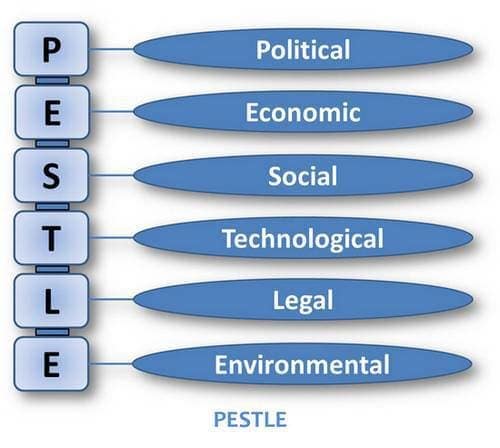
PESTLE analysis - Analysis of external business environment
PESTLE analysis
As we already mentioned in a previous article, the PEST analysis is considered a useful scanning tool for identifying the relevant political, economic, social and technological factors from the external environment. These factors can represent threats or opportunities as well as challenges arising from the external environment, which can greatly influence your decision making.
To read more on PEST analysis, click here.
A more complete version of PEST Analysis is PESTLE analysis. The upgradation of PESTLE analysis involves two new factors: the legislative and the environmental components. Initially, the legislative factors were included in the political and economic environment. However, as society is developing by leaps and bounds, legal factors have a critical role to play in decision making.
Similarly, environmental hazards have increased after the industrial revolution. And expanding businesses also have their own effects on the environment. Thus, where environment was considered to be included in the technological section, it began to be treated separately and had its own standing. We have seen that with groups like PETA, WWF, Greenpeace and others in full flow, there is an increasing demand for better environmental conditions with business expansion. These environmental groups cannot be ignored.
What exactly do the legal and the environmental factors of PESTLE analysis consist of? For this, let us go through all the various factors in PESTLE
Table of Contents
1) Political factors in PESTLE analysis
Politics plays an important role in all countries and there are ruling parties as well as opposition. If the business is going to face problems in politics then the same should be reflected in the PESTLE analysis report. This will help the company decide what steps should be taken to overcome the political challenges.
2) Economical factors in PESTLE analysis
Tomorrow, if a company in Kenya wants to expand in USA then it would not be economically viable. On the other hand, if a company in USA expands to Kenya, then the US company too would lose revenue because the variance in economic conditions between Kenya and US. Thus, while considering the external business environment, you have to take economical factors in consideration.
3) Social factors in PESTLE analysis
Will society accept the product you are offering or is the culture of the society negative towards your product? At the same time, what sociological factors are in play which can support your product and which are the social factors you will have to address when you launch your product? All these questions can be answered when you analyse social factors in PESTLE.
4) Technological factors in PESTLE analysis
Japan has taken years and decades to become the technological giant it is now. And this has been a contribution of many different companies like Sony and others. Moreover, the nation supported innovation due to which Japanese companies were at the fore front of quality. Thus technological factors play an important role in the success of an organization in a new business environment.
5) Legal factors in PESTLE analysis
Different legal factors like Import/export procedures, employment law, consumer protection, intellectual property law, copyright, patents, data protection, are just some of the factors which might influence your business from a legislative perspective. If any of these factors are not conducive for business, then you have to wait for the right time to enter the new business environment. Or you have to find a work around to these legal challenges.
6) Environmental factors in PESTLE analysis
Laws regulating environmental pollution, attitudes towards “green” solutions, endangered species, renewable energy utilization, waste management, climate change, recycling are just some of the environmental factors which you should consider in order to estimate the potential challenges and opportunities in the business context.
The legal factors have the power to influence the company’s operations as well as the demand for its products. On the other hand, by taking the environmental factors into consideration, you are one step closer to the process of innovation. By restructuring operations and getting involved in Green Business, companies are actually starting to answer some of the environmental problems of the world. This ensures lesser pollution and lesser degradation of natural resources.
Other alternatives of PESTLE analysis vary in the way of structuring and positioning the factors depending on the industry in which you operate, and what is relevant for the respective industry. Here are some other examples of variants of PESTLE analysis:
- STEP
- STEEP (where one of the factors is economic and the other one is ethics)
- SLEPT
- STEEPLED(social-technological-environmental-political-legislative-ethical-demographical)
- LONGPEST (local-national-global factors-PEST)
PESTLE analysis also represents a very useful tool in determining your competitive advantage. However, it is not to be forgotten that this is an external analysis tool which helps in strategic planning, being part of situation analysis. But if left alone, the only result you will get is just an overview of the environment of the industry in which your company operates.










